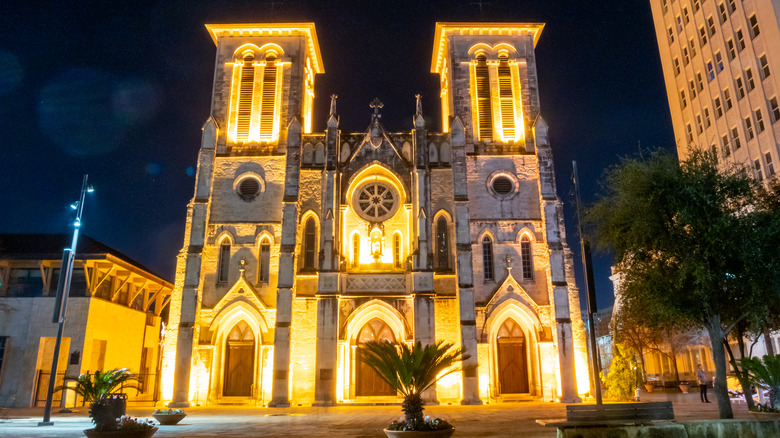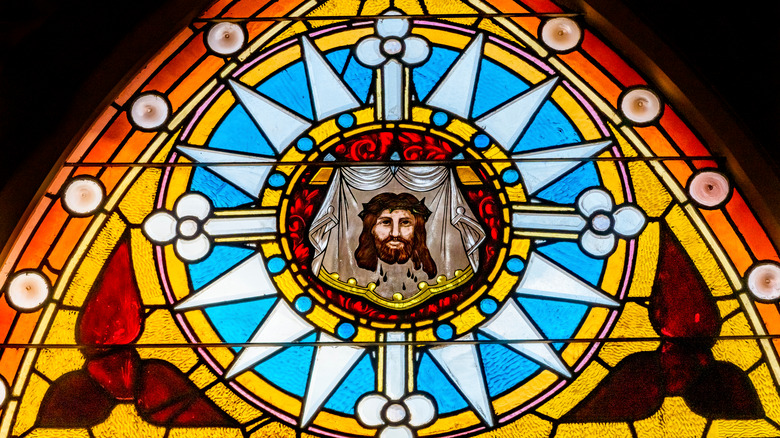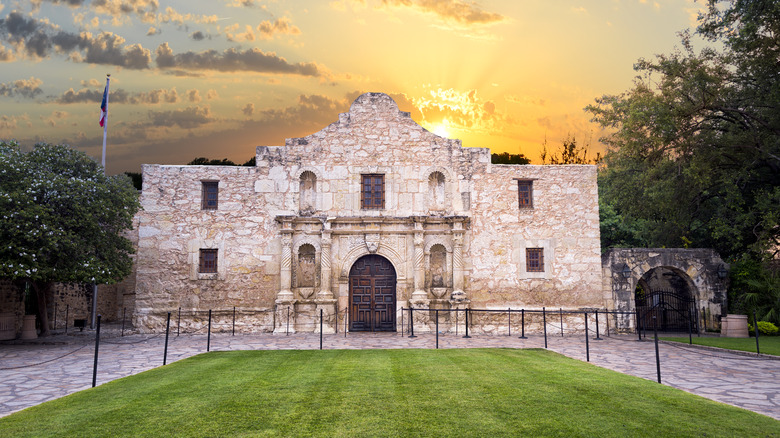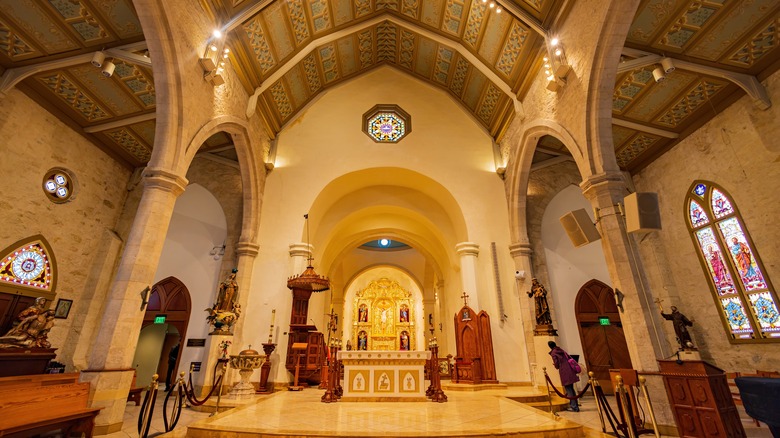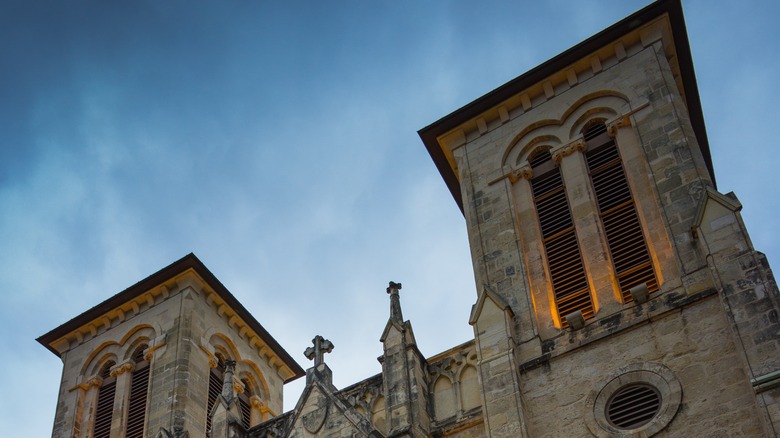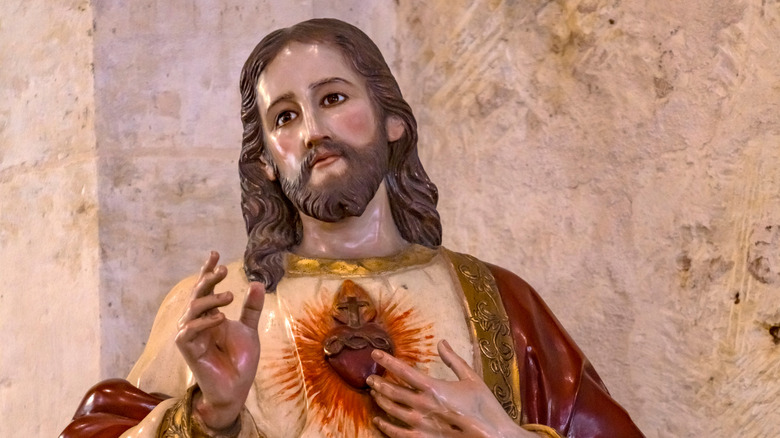Inside The Cathedral Said To Be One Of The Most Haunted Places In Texas
Many pivotal points in North American history have occurred in Texas; nowhere more so, perhaps, than in the central part of the state, near San Antonio. It was there in the 1830s where the legendary Battle of the Alamo took place, which proved to be a deadly and decisive skirmish in the conflict for Texan independence from Mexico and the Spanish empire, as History notes. Also in San Antonio is San Fernando Cathedral, the oldest church in the state, first built in the Gothic-revival style beginning in the 1730s by Canary Island settlers on behalf of the Spanish empire. That was some five years before construction on the Alamo Mission itself even began, and the church is still standing today.
Given the San Fernando Cathedral's long history and the many gruesome incidents to which it's borne witness, San Fernando is widely considered the most haunted location in Texas and among the most haunted locations in the U.S. In its lifetime, there have been skirmishes between indigenous populations and Spanish colonists and the nearby Battle of the Alamo itself. What's more, a number of poor souls lost their lives for a number of reasons and were laid to rest on the premises. With some historical background, here are just a few of the strangest and most supernatural things ever reported at San Fernando Cathedral, according to Ghost City Tours, a leading authority on San Antonio's haunted history.
The cathedral was first built by Canary Islanders
The earliest European colonial settlers in the area of San Fernando Cathedral and San Antonio came from the Canary Islands, a colony of Spain since the 15th century located just off the coast of the country (via Britannica). Some 13 years after the city of San Antonio itself was founded, the Canary Islanders were drawn to the San Antonio region with promises of land grants from the Spanish government, which was interested in consolidating Spanish presence in the area before France beat them to it, as Ghost City Tours explains. Before the first cornerstones of the San Fernando cathedral were laid in the 1730s, though, there was a conflict between the colonists and the local indigenous populations.
At first, the Lipan Apache rose up, and then the Comanche later on in the 1740s. Around that same time, brutal disputes raged between the colonists, the Apache, and the Comanche. Those skirmishes, battles, and sometimes all-out warfare took place between colonists and local indigenous populations and sometimes between the native peoples themselves. A short-lived peace was brokered early on in the history of the San Fernando Cathedral, at which time objects like hatchets were buried on the grounds (a widespread practice among North American indigenous populations, forming the basis for our modern expression, "bury the hatchet," according to History Extra). At that time, a white horse was also buried alive on the property, as Main Plaza, a San Antonio historical website, explains.
Remember the Alamo
The next most significant historical incident to occur in San Antonio near the San Fernando Cathedral was perhaps the Battle of the Alamo. This roughly two-week conflict between Spain and the Texas' militia, including famous names like Davy Crockett and James Bowie fighting for independence on behalf of the Lone Star state, ended in a victory for Spanish forces, led by General Santa Ana. The Spanish left none of the Texan rebels alive, who had fortified themselves in the Alamo Mission. Nonetheless, the rallying cry "Remember the Alamo" went down in history, said to have been called out at the time by Crockett, Bowie, and others as they bravely made their last stand.
Following the Battle of the Alamo, Santa Ana burned the bodies of the fallen in and around San Antonio, and none were given proper burials. Colonel Juan Seguín, who was the first mayor of San Antonio and only absent from the Alamo by chance when the Spanish finally defeated the uprising (via Britannica), would go on to become one of the new republic's most notable leaders once independence was won. Seguín, it's said, reburied those burned corpses of Alamo fallen on the grounds of the San Fernando Cathedral, although this version of history is disputed, as Ghost City Tours goes on to explain.
The dead were buried in the walls and under the floor
Over the centuries, as the city of San Antonio grew up around the San Fernando Cathedral, the structure remained a hub for Catholicism in the area, as scores of the faithful — numbering sometimes in the thousands — passed over its threshold, along with countless priests and monks. At times throughout this long history, it was common for Catholic believers to be buried within the walls of the church, as more high-ranking church members were laid to rest under the floor (via Ghost City Tours). Contributing to the structure's supernatural reputation, a box was uncovered in the 1930s during a period of renovation, and it contained charred remains, among other historical artifacts.
Some believed that what was found inside that box belonged to those who died at the Alamo, later relocated to Colonel Juan Seguín, but those items could have also belonged to Republican forces who died in the Battle of El Rosillo of 1813 (per the Texas State Historical Association). Perhaps due to this discovery — which was near a sarcophagus where the remains of historical figures like Davy Crocket are also allegedly buried — the long list of souls that met their end in and around the cathedral seems to have been disturbed. From that time forward, a number of unusual sightings in San Fernando Cathedral were reported, according to Condé Nast Traveler.
There's the ghost of a white horse, according to witnesses
Among the many unusual sightings reported at San Fernando are glowing orbs appearing in photographs without explanation and menacing faces emerging from the walls of the cathedral, which perhaps once belonged to those true believers interred inside the structure. What's more, the restless spirit of the white stallion buried alive on the grounds of the church as a peace offering hundreds of years earlier is also said to once more run free on the premises, per CultureMap San Antonio.
As late as 2007, renovation was again underway in the ancient building when the plaster was removed from the original stone in one area of the cathedral, according to Ghost City Tours. While this work was ongoing, a tourist inside the cathedral allegedly witnessed the apparition of a man kissing a skull near the sarcophagus where Davy Crockett and others are said to be buried. More often than not, though, incidents of supernatural sightings from those renovating the cathedral, as well as tourists themselves, are shadowy figures, often described as wearing clothing from the 18th or 19th centuries.
Monks of San Fernando cathedral may have never left
Several darkened figures have been spotted over the decades in the San Fernando Cathedral, one of which reportedly followed an individual while they were on a tour of the church. That's only one of a number of monk-like figures purportedly witnessed by visitors, manifesting, perhaps, from the walls where priests and monks were interred. One chilling detail among eyewitness accounts is that those monks sometimes have their hoods drawn over their heads as they appear and disappear without explanation, as Ghost City Tours goes on to report.
In at least a few cases, more than one person reportedly witnessed these specters at the same time, which only adds to the mystery. The truth of such supernatural occurrences is, of course, difficult to prove. What's plain to see, though, is that San Fernando Cathedral has long been a place for the Catholic faithful to gather, as well as a lightning rod for many significant and often violent events throughout history. Whether some dark energy of the dead has, in fact, gathered and manifested in the area because of this is a matter of much speculation.
